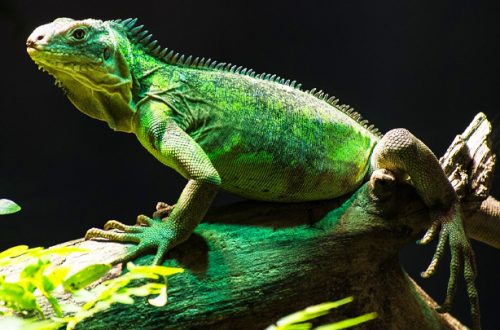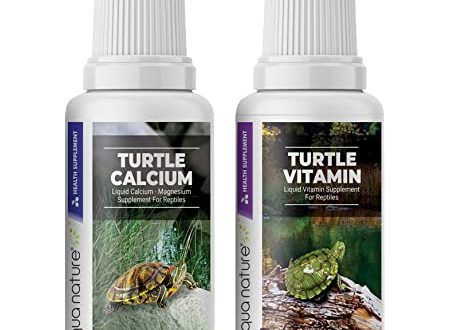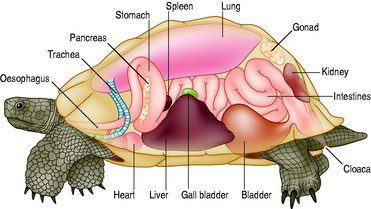
Тимпанија на желудникот кај желки

симптомите: does not sink, falls on its side, eats poorly, sits on the shore Желки: more often small water третман: може да се излечи сами
Симптоми:
An aquatic turtle does not sink in water, falls on its right side. Feces may consist of undigested food. May blow bubbles from the mouth, may vomit. The tortoise looks swollen near the legs (in the inguinal pits) and near the neck. If treatment with Espumizan does not help, an x-ray should be taken and checked for the presence of stuck foreign bodies. The roll of the turtle can also be on the left side if the gases are already in the distal intestine, in the colon. And in this case, Espumizan to give to no avail.
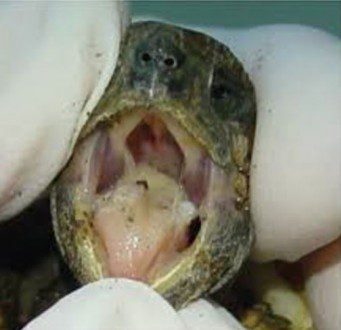
Причините:
Tympania (acute dilatation of the stomach) occurs for various reasons. Most often when overfeeding against the background of general lethargy of the gastrointestinal tract. Sometimes with a deficiency of calcium in the blood, which causes spasms of the intestines and the pyloric sphincter (the so-called krampi). Sometimes due to pylorospasm. Sometimes it is idiopathic (i.e., not caused by obvious causes) tympania, more common in turtles under the age of 2-3 months, which is not treated. This could simply be due to overeating or when changing food (most likely, you fed her not what she received in the store). It is also possible the presence of a foreign object in the pyloric sphincter or in the intestine. It is treated with calcium preparations, enterosorbents, antispasmodics and drugs that stimulate peristalsis, but the last two groups for turtles have limitations.
ВНИМАНИЕ: Режимите за третман на локацијата може да бидат застарени! Желка може да има неколку болести одеднаш, а многу болести е тешко да се дијагностицираат без тестови и преглед од ветеринар, затоа, пред да започнете со само-лекување, контактирајте со ветеринарна клиника со доверлив ветеринар херпетолог или нашиот ветеринарен консултант на форумот.
Шема на третман:
If the turtle is active, eats well, then for a start it is worth letting it starve for 3-4 days, most often this helps to restore flotation and do without injections.
- Calcium borgluconate 20% – 0,5 ml per kg (if not found, then human calcium gluconate 10% at the rate of 1 ml / kg) every other day, the course of treatment is 5-7 times.
- Dilute Espumizan for children with water 2-3 times and inject it with a probe into the stomach (Espumizan 0,1 ml is diluted with water to 1 ml, injected into the esophagus at the rate of 2 ml per kilogram of animal weight, i.e. 0,2 ml for every 100 grams weight) every other day 4-5 times.
- It is advisable to inject Eleovit 0,4 ml per kg (optional)
За третман треба да купите:
- Children’s Espumizan | 1 vial | human pharmacy
- Calcium Borgluconate | 1 vial | veterinary pharmacy
- Елеовит | 1 вијала | ветеринарна аптека
- Syringes 1 ml, 2 ml | human pharmacy
- Probe (tube) | human, vet. pharmacy
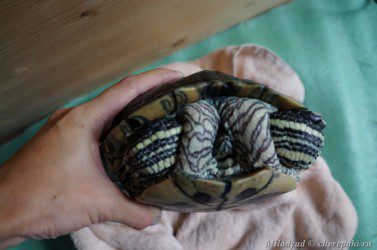
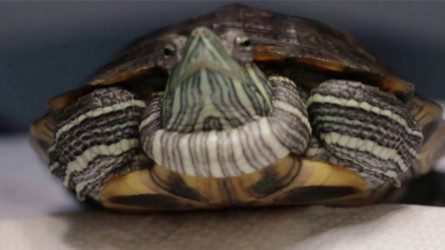
Tympania and pneumonia are often confused. How to distinguish?
This issue is complicated by the fact that these diseases occur in red-eared turtles with almost the same clinical picture: respiratory syndrome (breathing with an open mouth), mucus secretion from the oral cavity, as a rule, anorexia and roll when swimming on any side. However, the etiology and pathogenesis of tympania and pneumonia in red-eared turtles differ dramatically. Tympania in a young red-eared turtle develops, as a rule, against the background of a lack of calcium in the diet, with this disease, dynamic intestinal obstruction occurs in red-eared turtles (calcium ions are needed for normal contraction of the muscular membrane of the intestine), intestinal overflow with gases.
Pneumonia in the red-eared turtle develops due to the penetration of the pathogen into the lung parenchyma. The penetration of the pathogen can be carried out both endogenously, that is, inside the body (for example, with sepsis), and exogenously – from the environment.
The pathogenesis of the disease “pneumonia” in the red-eared turtle is due to an inflammatory reaction with the formation of exudate (liquid) in the lung parenchyma, a change in the density of the lung tissue, resulting in a heel when swimming.
The differential diagnosis of pneumonia from tympania of the red-eared turtle consists in the analysis of anamnesis data, clinical examination and additional studies. Data of anamnesis and clinical examination for tympania in a red-eared turtle may include a roll when swimming on any side or elevation of the posterior half of the body relative to the anterior (with swelling of the colon), anorexia. Periodic or persistent mucous discharge from the mouth and nasal cavity (unlike pneumonia in the red-eared turtle, mucous discharge is associated with regurgitation of stomach contents into the oral cavity). With this disease, red-eared turtles are also observed: stretching of the neck and breathing with an open mouth, swelling of the skin of the inguinal pits and skin in the neck and armpits (the turtle cannot be completely removed under the shell – this cannot be done due to excessive gas formation in the gastrointestinal tract).
Of the additional studies to clarify the diagnosis of “tympania” in the red-eared turtle, as a rule, an X-ray examination is performed in the dorso-ventral projection (Fig. 1), to detect gas accumulation in the intestinal loops. As a rule, it is not possible to qualitatively conduct and interpret X-ray images of the lungs (craniocaudal and latero-lateral projection) in young red-eared turtles weighing from several grams to several tens of grams, if pneumonia is suspected.
Another additional study to verify the diagnosis of the disease in red-eared turtles is a cytological examination of the mucous exudate released from the mouth. When tympania in a red-eared slider, a smear can show squamous non-keratinized epithelium of the mouth and esophagus, cylindrical epithelium of the stomach. With pneumonia in a red-eared turtle, a smear will determine the respiratory epithelium, inflammatory markers (heterophiles, macrophages), and a large number of bacteria.
Source: http://vetreptile.ru/?id=17
Прочитајте повеќе за:
- Tympania or pneumonia in red-eared sliders, that is the question
© 2005 — 2022 Turtles.ru




